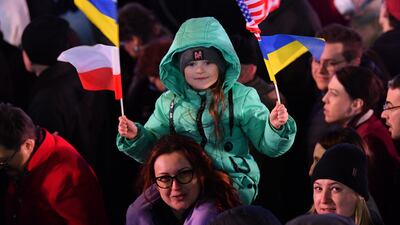The strategic compass that Nato leaders have been using in the wake of the Russian invasion of Ukraine still lacks precision. The same could be said for Moscow’s own compass, too.
The threat of weapons of mass destruction, including chemical weapons, are part of the calculus of all sides. US President Joe Biden said explicitly that in the event Russia deploys chemical weapons, then the US would respond. But the question remains – respond how, and where?
The Nato summit this week avoided using the traditional discourse of “red lines”, fearing implications not just in terms of Russian retaliation, but also due to awareness that any cost will be higher for the European states.
One of the key components of Nato’s strategic compass, according to Mr Biden, is the unprecedented unity in the ranks of the alliance. Beyond simple messaging about solidarity, practical steps are being taken to signal a possible expansion of Nato membership, increase military budgets for existing members and deploy more advanced weapons across Eastern Europe as well as Ukraine.
Yet, Ukrainian President Volodymyr Zelenskyy remains sceptical of Nato. To him, its achievements may be too little too late, and have come only from the ruins of Ukraine. “We are grateful…but”, Zelensky has said repeatedly. The Ukraine war is increasingly becoming a proxy battle between Russia and Nato, in which the latter refuses to intervene directly.
Mr Zelenskyy had clearly assumed Ukraine’s friendship with Nato would bring with it western protection from Russia. Instead, he is now caught in a Russian war on Ukraine that could lead to its official partition or complete disintegration, which he had probably never anticipated.
The morale of the Ukrainian people, army and volunteers remains high in contrast with the performance of Russian troops and equipment. There is global solidarity with Ukraine and largely Western outrage over Russia’s actions. But ultimately, Ukraine’s leaders may have averted this dark fate if they had not pursued so strongly an orientation towards Nato and the West.
Some may say – and rightly so – this is Ukraine’s sovereign right, and that it is up to the Ukrainian people to decide whether they face Westward or not. But the question Ukraine must now grapple with is whether such lofty values as self-determination truly do outweigh other geopolitical and strategic concerns. Recall how Iraq was transformed in the name of democracy from a key state in the regional equation to a fragmented and violated country, now dominated by sectarianism and Iranian hegemonic schemes. The point here is not to compare Ukraine and Iraq, but to recall how democracy, values and freedoms can be used to justify the destruction of states, deliberately…or otherwise.
None of this is to say that Russia has not miscalculated by launching its war in Ukraine. Moscow still believes that a strategy of further escalation with the West will force the US and the European powers to backtrack. The problem with escalation between rival great powers, however, is that both sides usually prefer to ratchet things up rather than back down.
The Nato and EU summit resolutions on Thursday seemed, of course, on the surface to be non-escalatory. Western leaders did not endorse the no-fly zone demanded by Mr Zelenskyy, which could have implicated Nato directly in the Ukraine conflict. They also did not draw lines in the sand or identify red lines, which is somewhat reassuring. However, these summits’ decisions are transitional, not final. In other words, while moves have been made to avoid a global crisis for now, the overall direction of confrontation rather than reconciliation is moving full steam ahead.
And while the Nato summit excluded the option of direct military confrontation with Russia, it has hinted at allowing states like Poland to take action if deemed necessary. The summit also approved a huge military aid package to Ukraine. But Russia is unlikely to sit idly by as Nato military aid flows into Ukraine. It has already indicated that it could attempt to destroy these weapons as they enter Ukrainian territory, raising risks of further confrontation.
The summits in Brussels also approved new sanctions aimed at preventing Russia from accessing its huge gold reserves, and Russia, in turn has weaponised its gas exports. Russian President Vladimir Putin has given energy giant Gazprom just one week to reach a deal with European nations that rely on Russian gas, led by Germany, Italy, Austria, and Hungary. Otherwise, Moscow could cut off gas supplies to these countries, some of which import up to 40 per cent of their needs from Russia.
Despite attempts by Turkey to mediate a solution between Russia and Ukraine and, by extension, the rest of Europe, so far, no such solution is on the horizon. So Russia's likely path forward until then is to step up its military operations in Ukraine.
Russia has miscalculated in this war, but Nato's calculations may not be much better. Despite Mr Biden's boasts of Nato unity, the fact that all of this escalation poses huge risks to the entire world economy will have a great impact on US and European public opinion. It is true that the West is more united than it has been in a long time, but it is an open question whether the costs of getting it there are worth it.


